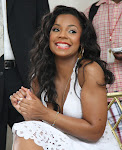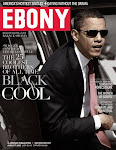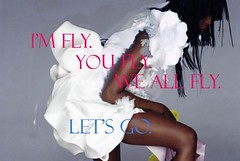Sunday, April 20, 2008
A HAIR STORY: One Mother's Journey To Learn Her Daughter's Heritage
Posted by THE fly GIRL at 10:22 AMThis story was sent to me by my best friend Angel - And it was so honest and beautiful, I thought I'd share it...See I can be nice ;o)
Thanks Ang, MUAHHHH!
Twists and turns
A story of hair and identity
By Aaryn Belfer
One of the first things my daughter says to me after waking each day—now that she’s evolved from the larval stage of infancy into a strategically manipulative human being—is “Please eat peanut-jelly.” Then she follows it, slowly shaking her head, with “No hair, mama. No hair today.” Generally speaking, I comply with her first request and override her second because the former is reasonable while the latter is non-negotiable. The child is nevertheless persistent in trying never to have her hair combed.
Still, we embark on an almost-daily ritual that is painful yet important for us both. To say Ruby wails when I comb her thick, kinky, lovely hair doesn’t quite begin to describe her emotional state. Wailing is serene compared to the drama that unfolds in my home. There is thrashing, jerking, writhing, kicking, slapping, bucking, drooling, farmer-hanky-ing (my personal favorite) and—the latest addition to the repertoire—a sustained, alienesque noise that seems to sharpen as it bends between the spaces of her teeth.
My next-door neighbor has obviously heard the commotion because she got it in her head last fall to express—to my face—her pleasure at hearing my daughter’s cries. Knowing that I suffer from parenting hardship makes her feel better, she said. (That she takes joy in my low points is another issue, but I will say this: We do not schedule play dates together.)
Over Christmas, while at a cabin with a group of friends, Ruby cleared the joint before the wide-toothed comb even touched her scalp. Her dramatic interpretation of seeing Jason’s masked face outside a cabin window began as soon as the Abebi’s Safari Detangler emerged from my toiletry bag. Our cabin mates quickly ushered their children outside to play, protecting them from my own little Linda Blair.
My friend Barbara likes to say that Ruby “acts a fool,” and in an attempt to normalize my experience, she has recounted for me memories of having her hair done as a child. A few months ago, during one of our hair-wrestling sessions, I stopped combing, took Ruby by the shoulders, looked into her eyes and explained calmly that doing her hair is my way of showing the world that I love her. Which is when Ruby stopped her shrieking, put her hands on my shoulders, looked into my eyes and explained calmly, “That crazy, mama.” Life really was easier before she had words.
Of course, that would seem crazy to a toddler and also the average (white) Joe, but it’s my reality; hair is a Big Deal for many in the black community. Which isn’t to say it’s not also important in the white community except that—it’s exactly not. The biological children of my white friends can wake up and run out the door and their hair hangs in place, never mind the cowlick here or the bedhead kink there. If their child has curly hair, it can blow wildly in the wind. Mussed hair is acceptable, intentional even.
But letting it all go is not a viable option for Ruby and me. How a black child’s hair is done is a reflection of how well she is cared for, valued and loved, and as the white mother of a black daughter, I’m under a high-power microscope.
Knowing this, I’ve put great emphasis into caring for Ruby’s hair, taking pride in its versatility so that she will, too. I’ve applied the generous advice, recommendations and instruction of my black friends and even strangers I’ve approached upon seeing a style I like.
Sometimes I leave Ruby’s hair in a Big Natural, a broad halo perfectly framing her heart-shaped face. I’ve learned to weave Ruby’s locks into soft coils, loose twists, swinging braids, full puffs and creative combinations of all those styles. I part her hair meticulously so the many intersections create starburst-like patterns on her head and there’s an undeniable feeling of accomplishment when I’m done with my creation. Instead of criticism, I’ve been praised—and earned respect, I think—for my handiwork.
I’m often asked—mostly by white people—whether it’s hard to do her hair, and I answer honestly: It’s not difficult. It’s just different. Of course, the combing is a challenge since my girl is tender-headed. Arriving at “the kitchen”—the most sensitive part of her head where easily tangled hairs grow at the nape of her neck—is always the worst. My child actress cries in mere anticipation of pain, fat tears flying horizontally from her eyes, head thrown back in self-preservation.
But once we get past the comb-out, she’ll sit patiently for elaborate styling generally dictated by her taste. “Braids!” she might shout, even going so far as to tell me, “Lots of braids!” Or she’ll say, “Two low puffs, mama,” instructing me where to place them. She’ll pick from a jumbled collection of colored balls, pastel snaps and felted bands to adorn her hair, and she selects barrettes when we’re out shopping. She recently deliberated with several hmmmms before choosing glittery red clips over purple butterflies. By letting her steer me, I hope to instill a sense of control, creativity, ownership and autonomy.
While we used to perform our ritual with her stationed on her changing table, these days she nestles between my knees, me on the couch, her seated low in front of me, her arms draped over my thighs, the video du jour offering distraction. As if her tears were connected to a spigot, my babe regains her composure the second I hand her the comb to put away. I work my fingers through her hair, kneading her scalp with shea butter or coconut oil, stopping now and again to land the irresistible kiss on the crown of her head. This hair time is ours, and it’s precious. It’s also as close as I’ll ever come to giving her an authentic African-American cultural experience, and my efforts have resulted in important connections to the black community, connections I’ll need to provide my child with more of what I—a white woman—cannot possibly give her.
Already, Ruby takes pride in her hair. She begs to look in the three-way mirror when we’re done, inspecting her ’do from all angles. She shakes her braids from side to side, eyes squeezed tight, and smiles at the noise from all the clips smacking together in a rhythm she creates. I like seeing her happy about her hair and know that our design tells a true story about how much she is adored.
Write to aaryn@sdcitybeat.com and editor@sdcitybeat.com.
Thanks Ang, MUAHHHH!
Twists and turns
A story of hair and identity
By Aaryn Belfer
One of the first things my daughter says to me after waking each day—now that she’s evolved from the larval stage of infancy into a strategically manipulative human being—is “Please eat peanut-jelly.” Then she follows it, slowly shaking her head, with “No hair, mama. No hair today.” Generally speaking, I comply with her first request and override her second because the former is reasonable while the latter is non-negotiable. The child is nevertheless persistent in trying never to have her hair combed.
Still, we embark on an almost-daily ritual that is painful yet important for us both. To say Ruby wails when I comb her thick, kinky, lovely hair doesn’t quite begin to describe her emotional state. Wailing is serene compared to the drama that unfolds in my home. There is thrashing, jerking, writhing, kicking, slapping, bucking, drooling, farmer-hanky-ing (my personal favorite) and—the latest addition to the repertoire—a sustained, alienesque noise that seems to sharpen as it bends between the spaces of her teeth.
My next-door neighbor has obviously heard the commotion because she got it in her head last fall to express—to my face—her pleasure at hearing my daughter’s cries. Knowing that I suffer from parenting hardship makes her feel better, she said. (That she takes joy in my low points is another issue, but I will say this: We do not schedule play dates together.)
Over Christmas, while at a cabin with a group of friends, Ruby cleared the joint before the wide-toothed comb even touched her scalp. Her dramatic interpretation of seeing Jason’s masked face outside a cabin window began as soon as the Abebi’s Safari Detangler emerged from my toiletry bag. Our cabin mates quickly ushered their children outside to play, protecting them from my own little Linda Blair.
My friend Barbara likes to say that Ruby “acts a fool,” and in an attempt to normalize my experience, she has recounted for me memories of having her hair done as a child. A few months ago, during one of our hair-wrestling sessions, I stopped combing, took Ruby by the shoulders, looked into her eyes and explained calmly that doing her hair is my way of showing the world that I love her. Which is when Ruby stopped her shrieking, put her hands on my shoulders, looked into my eyes and explained calmly, “That crazy, mama.” Life really was easier before she had words.
Of course, that would seem crazy to a toddler and also the average (white) Joe, but it’s my reality; hair is a Big Deal for many in the black community. Which isn’t to say it’s not also important in the white community except that—it’s exactly not. The biological children of my white friends can wake up and run out the door and their hair hangs in place, never mind the cowlick here or the bedhead kink there. If their child has curly hair, it can blow wildly in the wind. Mussed hair is acceptable, intentional even.
But letting it all go is not a viable option for Ruby and me. How a black child’s hair is done is a reflection of how well she is cared for, valued and loved, and as the white mother of a black daughter, I’m under a high-power microscope.
Knowing this, I’ve put great emphasis into caring for Ruby’s hair, taking pride in its versatility so that she will, too. I’ve applied the generous advice, recommendations and instruction of my black friends and even strangers I’ve approached upon seeing a style I like.
Sometimes I leave Ruby’s hair in a Big Natural, a broad halo perfectly framing her heart-shaped face. I’ve learned to weave Ruby’s locks into soft coils, loose twists, swinging braids, full puffs and creative combinations of all those styles. I part her hair meticulously so the many intersections create starburst-like patterns on her head and there’s an undeniable feeling of accomplishment when I’m done with my creation. Instead of criticism, I’ve been praised—and earned respect, I think—for my handiwork.
I’m often asked—mostly by white people—whether it’s hard to do her hair, and I answer honestly: It’s not difficult. It’s just different. Of course, the combing is a challenge since my girl is tender-headed. Arriving at “the kitchen”—the most sensitive part of her head where easily tangled hairs grow at the nape of her neck—is always the worst. My child actress cries in mere anticipation of pain, fat tears flying horizontally from her eyes, head thrown back in self-preservation.
But once we get past the comb-out, she’ll sit patiently for elaborate styling generally dictated by her taste. “Braids!” she might shout, even going so far as to tell me, “Lots of braids!” Or she’ll say, “Two low puffs, mama,” instructing me where to place them. She’ll pick from a jumbled collection of colored balls, pastel snaps and felted bands to adorn her hair, and she selects barrettes when we’re out shopping. She recently deliberated with several hmmmms before choosing glittery red clips over purple butterflies. By letting her steer me, I hope to instill a sense of control, creativity, ownership and autonomy.
While we used to perform our ritual with her stationed on her changing table, these days she nestles between my knees, me on the couch, her seated low in front of me, her arms draped over my thighs, the video du jour offering distraction. As if her tears were connected to a spigot, my babe regains her composure the second I hand her the comb to put away. I work my fingers through her hair, kneading her scalp with shea butter or coconut oil, stopping now and again to land the irresistible kiss on the crown of her head. This hair time is ours, and it’s precious. It’s also as close as I’ll ever come to giving her an authentic African-American cultural experience, and my efforts have resulted in important connections to the black community, connections I’ll need to provide my child with more of what I—a white woman—cannot possibly give her.
Already, Ruby takes pride in her hair. She begs to look in the three-way mirror when we’re done, inspecting her ’do from all angles. She shakes her braids from side to side, eyes squeezed tight, and smiles at the noise from all the clips smacking together in a rhythm she creates. I like seeing her happy about her hair and know that our design tells a true story about how much she is adored.
Write to aaryn@sdcitybeat.com and editor@sdcitybeat.com.
Labels: Simply Fly, The Writer's Room
Subscribe to:
Post Comments (Atom)












1 comments:
Hey there.
Just wanted to drop in to say a large Thank You for linking to my post. Mostly because now I know your site exists, and I can spend hours browsing instead of getting my work done.
Peace.
Post a Comment